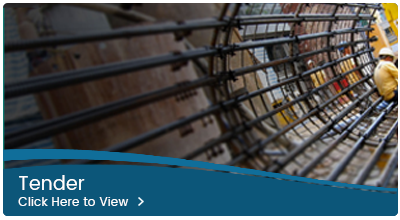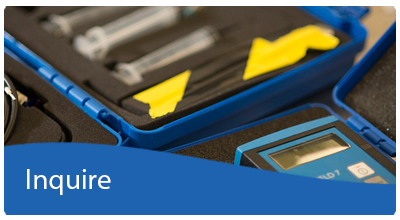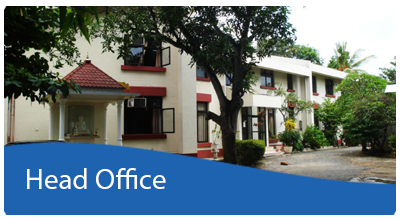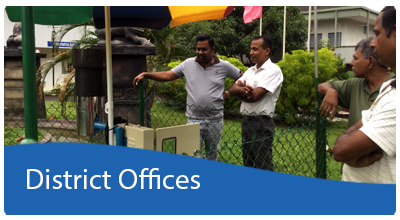Testing of the concrete specimen plays and important role to know about the strength, durability and condition of the structure. Generally the concrete testing on site can be categorized into two groups; Destructive and Non-Destructive testing.
Destructive Testing
This is an easy testing method of determining the depth of carbonation inside the hardened concrete. Due to the considerable damage caused, this test belongs to the destructive category. In this test, the change of color of Phenolphthalein is observed to identify the carbonated locations and the depth of carbonation. The depth of carbonation can be measured by using a ruler or a vernier caliper. Further, the depth of carbonation can be obtained from the extracted cores.


Testing Requirements
- The testing locations can be selected by the client, NBRO inspector, or another third party.
- If the selected locations have high elevation the client should provide and prepare scaffolding.
- The client should facilitate an electrical power supply.
The core extraction is extremely important to determine the compressive strength of hardened concrete. In addition to the main purpose of the core, extraction can be used to determine the concrete cover and the carbonation depth as well. The BMRTD is capable of conducting core extraction with the dimensions mentioned below.
- Core diameter 50 – 100 mm
- Core diameter 150 mm
Testing Requirements
- The testing locations can be selected by the client, NBRO inspector, or another third party.
- The client should facilitate a clear path to carry the heavyweight core drilling machine to the test location.
- The client should facilitate an electrical power supply.
- The client should facilitate a water supply.
- The client should clear the space under the drilling location.


This test measures the resistance to a pull-out load.
Testing Requirements
- The plasters or paints on the surface of the testing location should be removed.
- The testing locations can be selected by the client, NBRO inspector, or another third party.
- If the selected locations have high elevation the client should provide and prepare scaffoldings.
This test measures the penetration resistance against physical impact which leads to determining the surface hardness and thereafter the strength of concretes. The test is conducted by well-experienced professionals of the Building Material Research and Testing Division.


Testing Requirements
- The plasters or paints on the surface of the testing location should be removed.
- The testing locations can be selected by the client, NBRO inspector, or another third party.
- If the selected locations have high elevation the client should provide and prepare scaffoldings.
Non-destructive Testing
The cover meter test is a non-destructive test that is used to determine the location of reinforcement bars, bar size, and the depth of concrete cover. Also, the bar spacing and arrangement can interpret by using the data of the cover meter test. An advanced cover meter - Profometer 630 AI is used for the inspections under the supervision of highly skilled staff. The instrument can be used to determine the cover depth up to 185 mm and the accuracy is strongly depending on the depth of cover.
Testing Requirements
- The plasters on the surface of the testing location should be removed.
- The client should be informed of known details of the test parameters such as bar size, bar spacing, etc.
- The testing locations can be selected by the client, NBRO inspector, or another third party.
- If the selected locations have high elevations, the client should provide and prepare scaffoldings.



The test is designed to determine and analyze the corrosions in the reinforcement bars. The anodic and cathodic reaction and ion flow through the hardened concrete is used to determine the potential of the corroded locations. This testing was conducted by the professionals of the Building Material Research and Testing Division. new advanced equipment – “Profometer Corrosion” is used for the testing.
Testing Requirements
- The plasters or paints on the surface of the testing location should be removed.
- The testing locations can be selected by the client, NBRO inspector, or another third party.
- If the selected locations have high elevation the client should provide and prepare scaffolding.
- The client should facilitate an electrical power supply.
- It is better if the client can provide the age of construction.


Your text...

This is non-destructive testing designed to determine the surface hardened concrete. According to the rebound value obtained from the test, the strength of the concrete can be determined. The test can be performed vertically upward, vertically downward, and horizontal directions. The Building Material Research and Testing Division has well-calibrated re-bound hammers and the tests are conducted by well-experienced professionals.
Testing Requirements
- The plasters on the surface of the testing location should be removed.
- The testing locations can be selected by the client, NBRO inspector, or another third party.
- If the selected locations have high elevations, the client should provide and prepare scaffolding.
- The surface of the testing locations should be in dry condition.


The test is non-destructive testing which is designed to investigate the quality of the concrete. The ultrasonic pulses propagate through concrete are analyzed and the time taken represents the quality of the concrete. Ultrasonic pulses can propagate in high velocities inside the high dense concrete. Likewise, pulses can propagate in low velocities inside the low dense concrete. Further, the high porosity can lower the propagation velocity.
According to the condition of the testing location or the request, the testing method can be changed as mentioned below;
- Direct method (Columns or beams)
- Semi-direct method (Columns or beams)
- Indirect method. (Slabs)

Testing Requirements
- The plasters on the surface of the testing location should be removed.
- The testing locations can be selected by the client, NBRO inspector, or another third party.
- If the selected locations have high elevations, the client should provide and prepare scaffolding.
- The surface of the testing locations should be in dry condition.
Slump Test


For more information
Building Material Research and Testing Division
Tel: (011)2588946, 2503826, 2500354, 2503431
Extension: 657, 674, 684
Gmail:



































